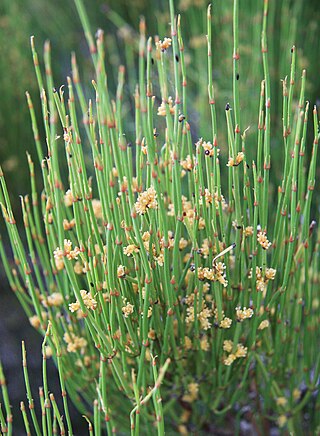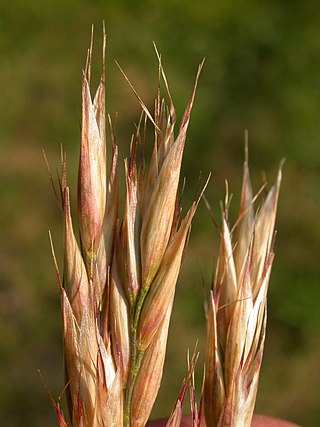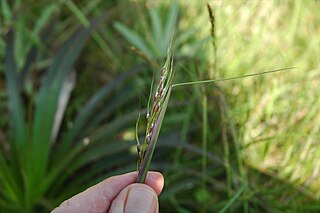
Bromus is a large genus of grasses, classified in its own tribe Bromeae. They are commonly known as bromes, brome grasses, cheat grasses or chess grasses. Estimates in the scientific literature of the number of species have ranged from 100 to 400, but plant taxonomists currently recognize around 160–170 species.

Grindelia (gumweed) is a genus of plants native to the Americas belonging to the family Asteraceae. The genus was named for Latvian botanist David Hieronymus Grindel, 1776–1836.

Brachyelytrum is a genus of North American and East Asian plants in the grass family, classified in its own tribe Brachyelytreae.

Ephedra is a genus of gymnosperm shrubs. The various species of Ephedra are widespread in many arid regions of the world, ranging across southwestern North America, southern Europe, northern Africa, southwest and central Asia, northern China and western South America. It is the only extant genus in its family, Ephedraceae, and order, Ephedrales, and one of the three living members of the division Gnetophyta alongside Gnetum and Welwitschia.

Triticeae is a botanical tribe within the subfamily Pooideae of grasses that includes genera with many domesticated species. Major crop genera found in this tribe include wheat, barley, and rye; crops in other genera include some for human consumption, and others used for animal feed or rangeland protection. Among the world's cultivated species, this tribe has some of the most complex genetic histories. An example is bread wheat, which contains the genomes of three species with only one being a wheat Triticum species. Seed storage proteins in the Triticeae are implicated in various food allergies and intolerances.

Hordeum jubatum, with common names foxtail barley, bobtail barley, squirreltail barley, and intermediate barley, is a perennial plant species in the grass family Poaceae. It occurs wild mainly in northern North America and adjacent northeastern Siberia. However, as it escaped often from gardens it can be found worldwide in areas with temperate to warm climates, and is considered a weed in many countries. The species is a polyploid and originated via hybridization of an East Asian Hordeum species with a close but extinct relative of Californian H. brachyantherum. It is grown as an ornamental plant for its attractive inflorescences and when done flowering for its inflorescence.

Hordeum murinum is a species of flowering plant in the grass family Poaceae, commonly known as wall barley or false barley. It is a close relative of cultivated barley.

Danthonia is a genus of Eurasian, North African, and American plants in the grass family. Members of this genus are sometimes referred to as oatgrass, but that common name is not restricted to this genus. Other common names include heathgrass and wallaby grass. Australian species have since been reclassified into the genus Rytidosperma.

Hordeum pusillum, also known as little barley, is an annual grass native to most of the United States and southwestern Canada. It arrived via multiple long-distance dispersals of a southern South American species of Hordeum about one million years ago. Its closest relatives are therefore not the other North American taxa like meadow barley or foxtail barley, but rather Hordeum species of the Pampas of central Argentina and Uruguay. It is less closely related to the Old World domesticated barley, from which it diverged about 12 million years ago. It is diploid.

Barley, a member of the grass family, is a major cereal grain grown in temperate climates globally. It was one of the first cultivated grains; it was domesticated in the Fertile Crescent around 9000 BC, giving it nonshattering spikelets and making it much easier to harvest. Its use then spread throughout Eurasia by 2000 BC. Barley prefers relatively low temperatures to grow, and well-drained soil. It is relatively tolerant of drought and soil salinity, but is less winter-hardy than wheat or rye.

Piptochaetium, or speargrass, is a genus of plants in the grass family, native to North and South America. Piptochaetium is a bunchgrass genus in the tribe Stipeae.
Littledalea is a genus of Asian plants in the grass family, native to mountains in China and neighboring countries. The genus is placed in its own tribe Littledaleae within subfamily Pooideae. The isolated tribe seems to be sister to the tribes Bromeae and Triticeae.
Hordeum intercedens is a diploid, annual species of wild barley known by the common names bobtail barley and vernal barley. It is native to southern California and northern Baja California, where it is an increasingly rare member of the flora in saline and alkaline soils near seasonal waterflows and vernal pool habitats. Today most occurrences are located on the Channel Islands of California; many of the occurrences known from the mainland have been extirpated in the process of land development. This is an annual grass growing erect to bent in small tufts with stems up to 40 centimeters long. The inflorescence is a green spike up to 6.5 centimeters long made up of awned spikelets between 1 and 2 centimeters long.

Distichlis is a genus of American and Australian plants in the grass family. Plants in this genus are dioecious, have rhizomes or stolons, and have conspicuously distichous leaves.
South and West Asia consists of a wide region extending from the present-day country of Turkey in the west to Bangladesh and India in the east.

Elymus caninus, the bearded couch or bearded wheatgrass, is a species of flowering plant in the family Poaceae that is native to Europe including the UK but can be found introduced in the US states of Oregon and Washington. E. caninus has been observed in two morphotypes; the first population being "pauciflorum," with the second being "caninus."

Hordeum spontaneum, commonly known as wild barley or spontaneous barley, is the wild form of the grass in the family Poaceae that gave rise to the cereal barley. Domestication is thought to have occurred on two occasions, first about ten thousand years ago in the Fertile Crescent and again later, several thousand kilometres further east.
Hordeum muticum is a species of wild barley in the grass family Poaceae, native to the high central Andes; Peru, Bolivia, northern Chile, and northern Argentina, and introduced to Ecuador. A diploid, its closest relative is Hordeum cordobense, a lowland species with a more southerly distribution.
Hordeum cordobense is a species of wild barley in the grass family Poaceae, native to northern Argentina. A diploid found below 1,000 m (3,300 ft), its closest relative is Hordeum muticum, a highland species with a more northerly distribution.
Hordeum aegiceras, the grim barley, is a species of flowering plant in the family Poaceae. It is native to Mongolia, Tibet, Qinghai, and central China, and it has been introduced into other locales around the world, including Argentina and the U.S. state of Illinois. An annual reaching 40 to 80 cm, it is cultivated at elevations above 3,000 m (9,800 ft).














